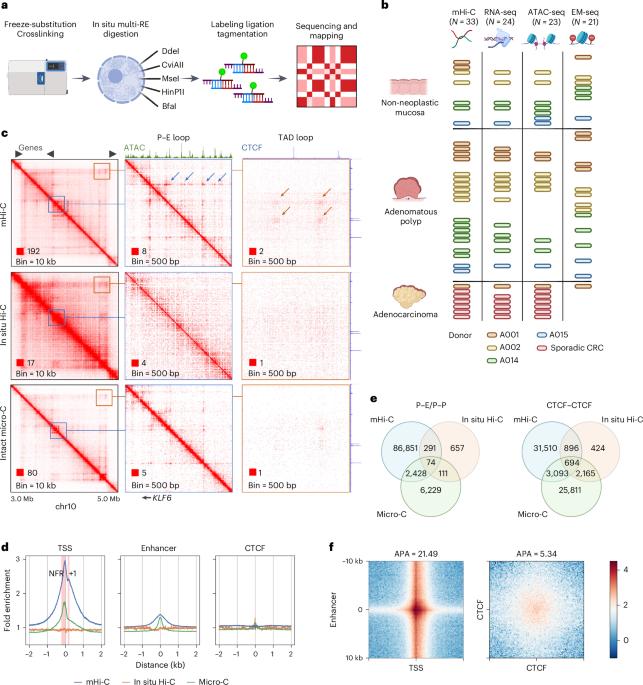Global loss of promoter–enhancer connectivity and rebalancing of gene expression during early colorectal cancer carcinogenesis
IF 23.5
1区 医学
Q1 ONCOLOGY
引用次数: 0
Abstract
Although three-dimensional (3D) genome architecture is crucial for gene regulation, its role in disease remains elusive. We traced the evolution and malignant transformation of colorectal cancer (CRC) by generating high-resolution chromatin conformation maps of 33 colon samples spanning different stages of early neoplastic growth in persons with familial adenomatous polyposis (FAP). Our analysis revealed a substantial progressive loss of genome-wide cis-regulatory connectivity at early malignancy stages, correlating with nonlinear gene regulation effects. Genes with high promoter–enhancer (P–E) connectivity in unaffected mucosa were not linked to elevated baseline expression but tended to be upregulated in advanced stages. Inhibiting highly connected promoters preferentially represses gene expression in CRC cells compared to normal colonic epithelial cells. Our results suggest a two-phase model whereby neoplastic transformation reduces P–E connectivity from a redundant state to a rate-limiting one for transcriptional levels, highlighting the intricate interplay between 3D genome architecture and gene regulation during early CRC progression. Snyder and colleagues show global loss of promoter–enhancer connectivity during early colorectal carcinogenesis and the dependency of gene dysregulation during this process on the baseline of promoter–enhancer interaction in normal colonic epithelium.

早期结直肠癌癌变过程中启动子-增强子连接的全面丧失和基因表达的再平衡。
虽然三维(3D)基因组结构对基因调控至关重要,但它在疾病中的作用仍然难以捉摸。我们对家族性腺瘤性息肉病(FAP)患者早期肿瘤生长的不同阶段的 33 个结肠样本生成了高分辨率染色质构象图,从而追溯了结直肠癌(CRC)的进化和恶变过程。我们的分析表明,在恶性肿瘤的早期阶段,全基因组顺式调控连通性逐渐丧失,这与非线性基因调控效应有关。在未受影响的粘膜中,启动子-增强子(P-E)连接性高的基因与基线表达的升高无关,但在晚期却有上调的趋势。与正常结肠上皮细胞相比,抑制高连接启动子会优先抑制 CRC 细胞中的基因表达。我们的研究结果表明了一个两阶段模型,在该模型中,肿瘤转化将 P-E 连接从冗余状态降低到转录水平的限速状态,突出了三维基因组结构和基因调控在 CRC 早期进展过程中错综复杂的相互作用。
本文章由计算机程序翻译,如有差异,请以英文原文为准。
求助全文
约1分钟内获得全文
求助全文
来源期刊

Nature cancer
Medicine-Oncology
CiteScore
31.10
自引率
1.80%
发文量
129
期刊介绍:
Cancer is a devastating disease responsible for millions of deaths worldwide. However, many of these deaths could be prevented with improved prevention and treatment strategies. To achieve this, it is crucial to focus on accurate diagnosis, effective treatment methods, and understanding the socioeconomic factors that influence cancer rates.
Nature Cancer aims to serve as a unique platform for sharing the latest advancements in cancer research across various scientific fields, encompassing life sciences, physical sciences, applied sciences, and social sciences. The journal is particularly interested in fundamental research that enhances our understanding of tumor development and progression, as well as research that translates this knowledge into clinical applications through innovative diagnostic and therapeutic approaches. Additionally, Nature Cancer welcomes clinical studies that inform cancer diagnosis, treatment, and prevention, along with contributions exploring the societal impact of cancer on a global scale.
In addition to publishing original research, Nature Cancer will feature Comments, Reviews, News & Views, Features, and Correspondence that hold significant value for the diverse field of cancer research.
 求助内容:
求助内容: 应助结果提醒方式:
应助结果提醒方式:


